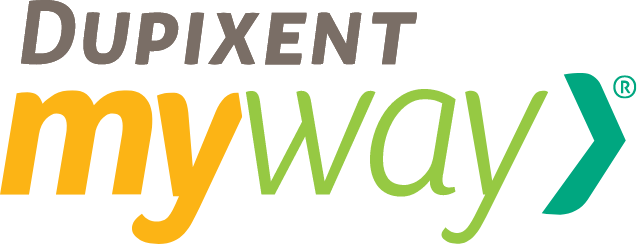
From initial FDA approvala
SINCE 2017, ≈253,000
PATIENTS HAVE FILLED AT
LEAST
1 DUPIXENT
PRESCRIPTIONb,c
a FDA approved since 2017 for adults, 2019 for adolescents (aged 12‑17 years), 2020 for children (aged 6-11 years),
and 2022 for infants to preschoolers (aged 6 months-5 years) with uncontrolled moderate‑to‑severe atopic dermatitis.
b IQVIA National Source of Business (NSOB) data as of April 2022.
c New adult and pediatric patients with uncontrolled moderate‑to‑severe atopic dermatitis.
Extensive Real-World
Experience IN AD
prescribed biologic by
dermatologists and allergists1,a,b
years since initial FDA
approval in AD in adults2,c
In the US,
studied in 17 pivotal trials
across 5 indications2
Globally,
≈800,000
patients on
DUPIXENT therapy
worldwide
across 5 indications1,g,i
patients on
DUPIXENT therapy
worldwide across
5 indications 1,g,i
RECOMMENDATION FOR
DUPIXENT3,4,f
Make DUPIXENT a part of
your standard of care
for appropriate
uncontrolled
moderate-to-severe
AD patients
specialty systemic therapy
with a phase 3 study
in atopic dermatitis
patients aged 12+ years with
moderate-to-severe hand
and/or foot involvement
SEE THE DATAACCESS among specialty
systemic therapies
indicated for ad1,g-i
AAAAI, American Academy of Allergy, Asthma, and Immunology; AAD, American Academy of Dermatology; ACAAI, American College of Allergy, Asthma, and Immunology.
aIQVIA NBRx data as of March 2024.
bIQVIA NBRx data as of March 2024.
cFDA approved for uncontrolled moderate-to-severe AD since 2017 for adults, 2019 for adolescents (aged 12-17 years), 2020 for children (aged 6-11 years), and 2022 for infants to preschoolers (aged 6 months to 5 years).
dThe worldwide patient number is largely comprised of patients treated with DUPIXENT from 10 countries (Canada, China, France, Germany, Italy, Japan, the Netherlands, Spain, UK, and US) and the rest of the world comprising ≈10% of this worldwide patient number. Data through December 2023.
e≈493,000 US patients (new adult and pediatric patients 6+ months of age with uncontrolled moderate-to-severe AD) have filled at least 1 DUPIXENT prescription based on IQVIA National Source of Business (NSOB) data as of March 2024.
fInclusion in AAD and AAAAI/ACAAI AD Guidelines does not denote endorsement or recommendation of product use by AAD or AAAAI/ACAAI.
g99% of commercial AD patients (6+ months of age) nationally are covered for DUPIXENT. 91% of commercial AD patient lives have to fail only 1 or 2 prescription topical treatments.
hMMIT Analysis March 2024. Analysis included DUPIXENT, tralokinumab, upadacitinib, and abrocitinib.
iBased on available published commercial UM coverage criteria.
Discover more experience with DUPIXENT
DUPIXENT HAS A DEMONSTRATED
SAFETY PROFILE2
Most common adverse reactions (incidence ≥1%) in patients with atopic dermatitis are injection site
reactions, conjunctivitis, blepharitis, oral herpes, keratitis, eye pruritus, other herpes simplex virus
infection, dry eye, and eosinophilia
The First and Only Therapy to Target IL‑4Rα, Thereby
SPECIFICALLY Inhibiting IL‑4 and IL‑13 Signaling2
The mechanism of dupilumab action has not been definitively established
THE DUPIXENT PROFILE
NOT AN
IMMUNOSUPPRESSANT
OR A STEROID2
NO INITIAL LAB TESTING OR
ONGOING LAB MONITORING
according to the Prescribing Information2
NO KNOWN DRUG‑TO‑DRUG
INTERACTIONS2
- Not metabolized through the liver or
excreted through the kidneys
NO boxed warning2
Please see additional Warnings and
Precautions in the Prescribing Information
and Important Safety Information below.
Select Important Safety Information
Warnings and Precautions
- Hypersensitivity: Hypersensitivity reactions, including anaphylaxis, serum sickness or serum sickness-like reactions,
angioedema, generalized urticaria, rash, erythema nodosum, and erythema multiforme have been reported. If a clinically
significant hypersensitivity reaction occurs, institute appropriate therapy and discontinue DUPIXENT
Discover how DUPIXENT inhibits IL-4 and IL-13 signaling
First and only biologic approved to treat
uncontrolled moderate-to-severe atopic dermatitis
from infancy to adulthood (6+ MONTHS of age)
Discover who may be appropriate for DUPIXENT
Learn what signs and symptoms to look for in uncontrolled moderate-to-severe atopic
dermatitis and who might be ready for DUPIXENT.
Review case studies to help identify appropriate patients in your practice

DUPIXENT MyWay is a patient support program that can help enable access to DUPIXENT and offers financial assistance for eligible patients, one-on-one nursing support, and more.







